Critical Review: Influence of Organisational Values on Problem Solving
VerifiedAdded on 2022/10/04
|8
|1796
|12
Report
AI Summary
This report provides a critical review of two resources focusing on organisational values and their impact on problem-solving. The first resource, a TED Talk by Ann Rhoades, emphasizes the importance of organisational values and their alignment with individual values and competencies, using real-life examples and behavioral hiring methodologies. The second resource, an article by Malbasic, Rey, and Potocan, explores the concept of balanced organisational values and examines various theories and models, including the Balanced Needs Scorecard, Balanced Scorecard, Competing Values Framework, Schwartz’s Values Model, and Management by Missions Model, to assess their applicability in contemporary business settings. The report compares and contrasts the resources, highlighting the importance of organisational values in influencing structured problem-solving processes. It concludes that organizational values are essential for resolving issues and enhancing overall performance.
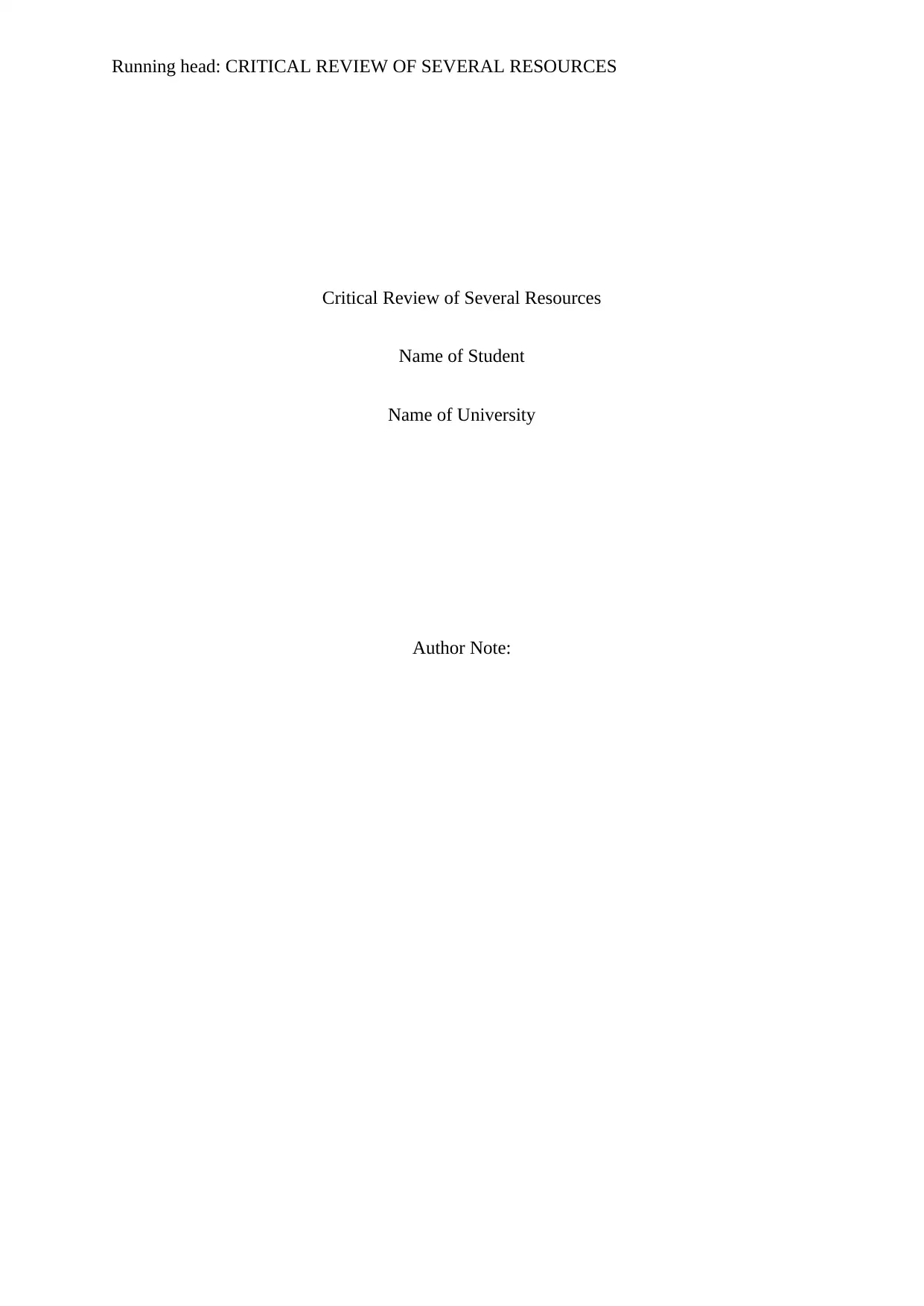
Running head: CRITICAL REVIEW OF SEVERAL RESOURCES
Critical Review of Several Resources
Name of Student
Name of University
Author Note:
Critical Review of Several Resources
Name of Student
Name of University
Author Note:
Paraphrase This Document
Need a fresh take? Get an instant paraphrase of this document with our AI Paraphraser
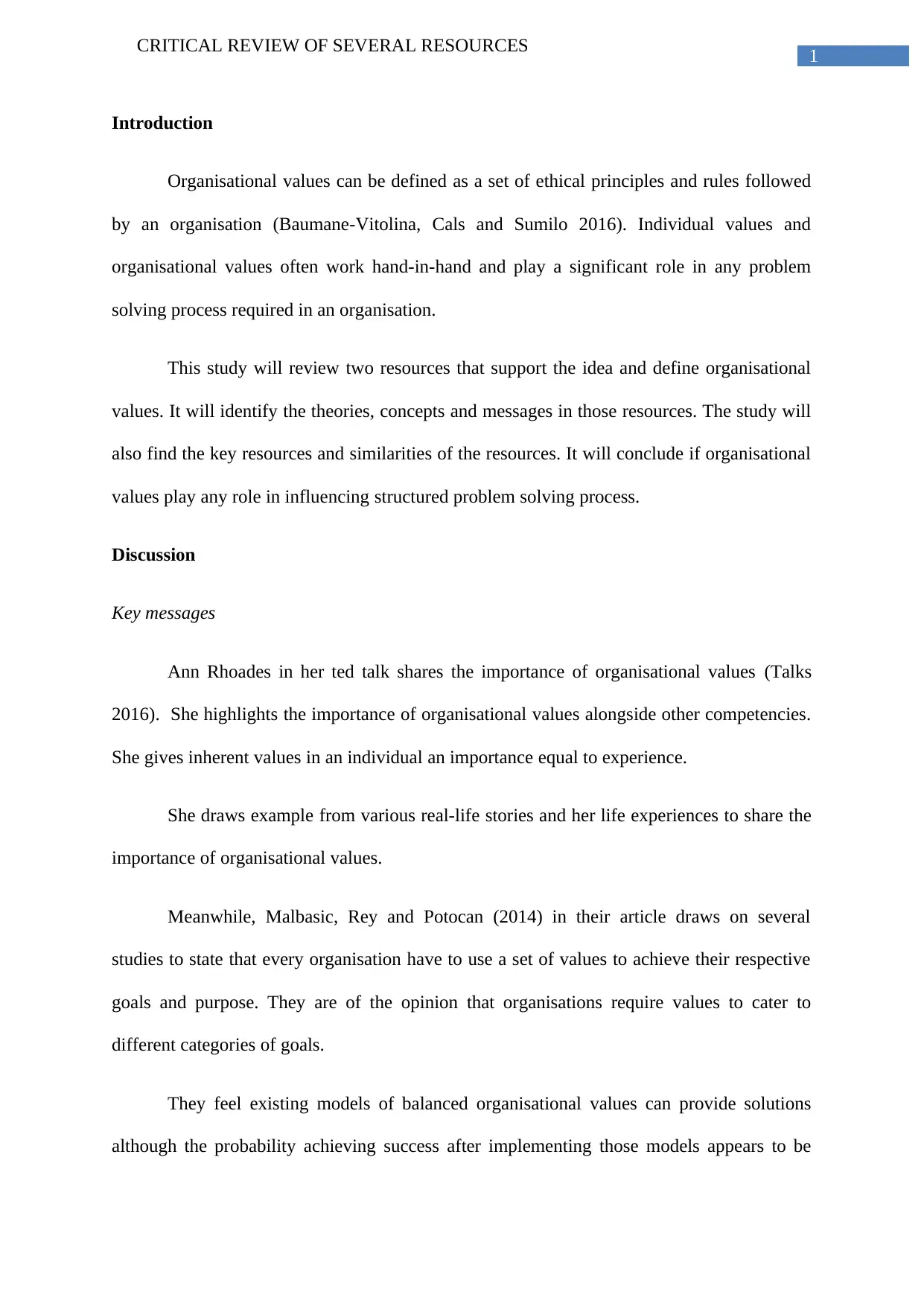
1
CRITICAL REVIEW OF SEVERAL RESOURCES
Introduction
Organisational values can be defined as a set of ethical principles and rules followed
by an organisation (Baumane-Vitolina, Cals and Sumilo 2016). Individual values and
organisational values often work hand-in-hand and play a significant role in any problem
solving process required in an organisation.
This study will review two resources that support the idea and define organisational
values. It will identify the theories, concepts and messages in those resources. The study will
also find the key resources and similarities of the resources. It will conclude if organisational
values play any role in influencing structured problem solving process.
Discussion
Key messages
Ann Rhoades in her ted talk shares the importance of organisational values (Talks
2016). She highlights the importance of organisational values alongside other competencies.
She gives inherent values in an individual an importance equal to experience.
She draws example from various real-life stories and her life experiences to share the
importance of organisational values.
Meanwhile, Malbasic, Rey and Potocan (2014) in their article draws on several
studies to state that every organisation have to use a set of values to achieve their respective
goals and purpose. They are of the opinion that organisations require values to cater to
different categories of goals.
They feel existing models of balanced organisational values can provide solutions
although the probability achieving success after implementing those models appears to be
CRITICAL REVIEW OF SEVERAL RESOURCES
Introduction
Organisational values can be defined as a set of ethical principles and rules followed
by an organisation (Baumane-Vitolina, Cals and Sumilo 2016). Individual values and
organisational values often work hand-in-hand and play a significant role in any problem
solving process required in an organisation.
This study will review two resources that support the idea and define organisational
values. It will identify the theories, concepts and messages in those resources. The study will
also find the key resources and similarities of the resources. It will conclude if organisational
values play any role in influencing structured problem solving process.
Discussion
Key messages
Ann Rhoades in her ted talk shares the importance of organisational values (Talks
2016). She highlights the importance of organisational values alongside other competencies.
She gives inherent values in an individual an importance equal to experience.
She draws example from various real-life stories and her life experiences to share the
importance of organisational values.
Meanwhile, Malbasic, Rey and Potocan (2014) in their article draws on several
studies to state that every organisation have to use a set of values to achieve their respective
goals and purpose. They are of the opinion that organisations require values to cater to
different categories of goals.
They feel existing models of balanced organisational values can provide solutions
although the probability achieving success after implementing those models appears to be
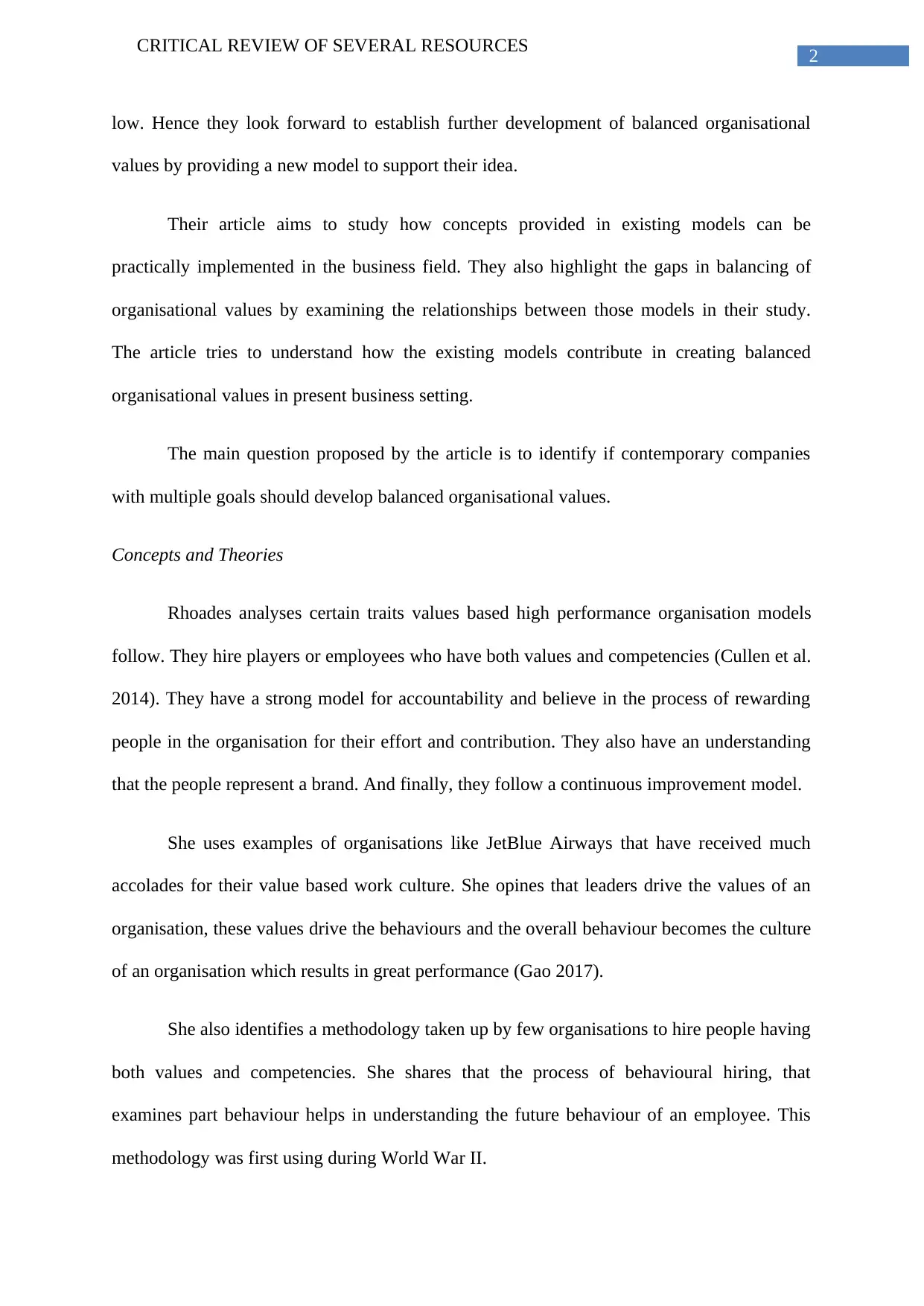
2
CRITICAL REVIEW OF SEVERAL RESOURCES
low. Hence they look forward to establish further development of balanced organisational
values by providing a new model to support their idea.
Their article aims to study how concepts provided in existing models can be
practically implemented in the business field. They also highlight the gaps in balancing of
organisational values by examining the relationships between those models in their study.
The article tries to understand how the existing models contribute in creating balanced
organisational values in present business setting.
The main question proposed by the article is to identify if contemporary companies
with multiple goals should develop balanced organisational values.
Concepts and Theories
Rhoades analyses certain traits values based high performance organisation models
follow. They hire players or employees who have both values and competencies (Cullen et al.
2014). They have a strong model for accountability and believe in the process of rewarding
people in the organisation for their effort and contribution. They also have an understanding
that the people represent a brand. And finally, they follow a continuous improvement model.
She uses examples of organisations like JetBlue Airways that have received much
accolades for their value based work culture. She opines that leaders drive the values of an
organisation, these values drive the behaviours and the overall behaviour becomes the culture
of an organisation which results in great performance (Gao 2017).
She also identifies a methodology taken up by few organisations to hire people having
both values and competencies. She shares that the process of behavioural hiring, that
examines part behaviour helps in understanding the future behaviour of an employee. This
methodology was first using during World War II.
CRITICAL REVIEW OF SEVERAL RESOURCES
low. Hence they look forward to establish further development of balanced organisational
values by providing a new model to support their idea.
Their article aims to study how concepts provided in existing models can be
practically implemented in the business field. They also highlight the gaps in balancing of
organisational values by examining the relationships between those models in their study.
The article tries to understand how the existing models contribute in creating balanced
organisational values in present business setting.
The main question proposed by the article is to identify if contemporary companies
with multiple goals should develop balanced organisational values.
Concepts and Theories
Rhoades analyses certain traits values based high performance organisation models
follow. They hire players or employees who have both values and competencies (Cullen et al.
2014). They have a strong model for accountability and believe in the process of rewarding
people in the organisation for their effort and contribution. They also have an understanding
that the people represent a brand. And finally, they follow a continuous improvement model.
She uses examples of organisations like JetBlue Airways that have received much
accolades for their value based work culture. She opines that leaders drive the values of an
organisation, these values drive the behaviours and the overall behaviour becomes the culture
of an organisation which results in great performance (Gao 2017).
She also identifies a methodology taken up by few organisations to hire people having
both values and competencies. She shares that the process of behavioural hiring, that
examines part behaviour helps in understanding the future behaviour of an employee. This
methodology was first using during World War II.
⊘ This is a preview!⊘
Do you want full access?
Subscribe today to unlock all pages.

Trusted by 1+ million students worldwide
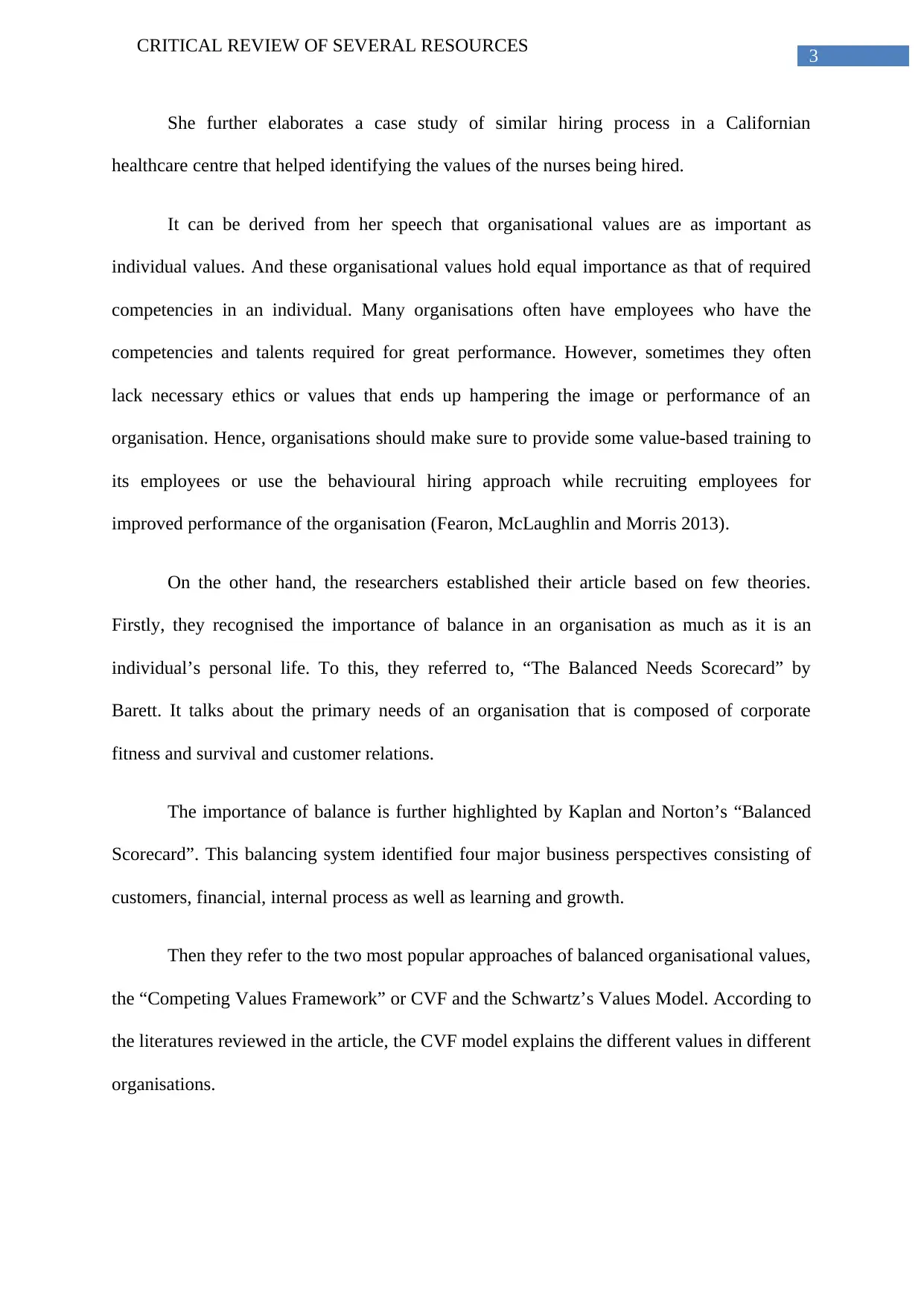
3
CRITICAL REVIEW OF SEVERAL RESOURCES
She further elaborates a case study of similar hiring process in a Californian
healthcare centre that helped identifying the values of the nurses being hired.
It can be derived from her speech that organisational values are as important as
individual values. And these organisational values hold equal importance as that of required
competencies in an individual. Many organisations often have employees who have the
competencies and talents required for great performance. However, sometimes they often
lack necessary ethics or values that ends up hampering the image or performance of an
organisation. Hence, organisations should make sure to provide some value-based training to
its employees or use the behavioural hiring approach while recruiting employees for
improved performance of the organisation (Fearon, McLaughlin and Morris 2013).
On the other hand, the researchers established their article based on few theories.
Firstly, they recognised the importance of balance in an organisation as much as it is an
individual’s personal life. To this, they referred to, “The Balanced Needs Scorecard” by
Barett. It talks about the primary needs of an organisation that is composed of corporate
fitness and survival and customer relations.
The importance of balance is further highlighted by Kaplan and Norton’s “Balanced
Scorecard”. This balancing system identified four major business perspectives consisting of
customers, financial, internal process as well as learning and growth.
Then they refer to the two most popular approaches of balanced organisational values,
the “Competing Values Framework” or CVF and the Schwartz’s Values Model. According to
the literatures reviewed in the article, the CVF model explains the different values in different
organisations.
CRITICAL REVIEW OF SEVERAL RESOURCES
She further elaborates a case study of similar hiring process in a Californian
healthcare centre that helped identifying the values of the nurses being hired.
It can be derived from her speech that organisational values are as important as
individual values. And these organisational values hold equal importance as that of required
competencies in an individual. Many organisations often have employees who have the
competencies and talents required for great performance. However, sometimes they often
lack necessary ethics or values that ends up hampering the image or performance of an
organisation. Hence, organisations should make sure to provide some value-based training to
its employees or use the behavioural hiring approach while recruiting employees for
improved performance of the organisation (Fearon, McLaughlin and Morris 2013).
On the other hand, the researchers established their article based on few theories.
Firstly, they recognised the importance of balance in an organisation as much as it is an
individual’s personal life. To this, they referred to, “The Balanced Needs Scorecard” by
Barett. It talks about the primary needs of an organisation that is composed of corporate
fitness and survival and customer relations.
The importance of balance is further highlighted by Kaplan and Norton’s “Balanced
Scorecard”. This balancing system identified four major business perspectives consisting of
customers, financial, internal process as well as learning and growth.
Then they refer to the two most popular approaches of balanced organisational values,
the “Competing Values Framework” or CVF and the Schwartz’s Values Model. According to
the literatures reviewed in the article, the CVF model explains the different values in different
organisations.
Paraphrase This Document
Need a fresh take? Get an instant paraphrase of this document with our AI Paraphraser

4
CRITICAL REVIEW OF SEVERAL RESOURCES
Similarly, the Schwartz’s Values Model identifies ten different motivational values
presented in a circular dimension with the most compatible values beside each other and the
contrasting values opposite to each other. This theory defined that all motivational types of
values are universally similar for all organisations. Later, many studies argued that the model
is more useful to general society rather than an organisational setting.
To understand a contrasting view the article also refers to the “Management by
Missions Model” by Cardona and Rey that provides an opinion on organisational values other
than a psychological value. This theory states that organisational values should consider
business, relational, development and contribution values to fulfil the mission of an
organisation.
To analyse the main purpose of the article, these models were implemented on
Fortune 100 Companies by the researchers through the “Measure of (Im)balance technique. It
was deciphered that the third model of MBM represents the balance of organisational values
in today’s business.
In conclusion, the article combines the latest MBM model with the two traditional
models to establish balanced organisational values in the present day. And it can certainly be
useful in contemporary organisations. The integrative model provides a combination of all
the major ideas presented in other theories. As organisations today cater to multiple goals and
hence a categorization of the values required to meet those goals. The proposed model can
certainly help the categorization. Moreover, the different set of values can be used to meet
different goals (Huhtala et al. 2013). The business values can help achieve self-oriented
stability in employees. With the relational values an organisation can attain social stability.
The developmental values becomes essential as it provides ways to achieve progress and
establish innovative ways of work. Finally, the contribution values can provide an
CRITICAL REVIEW OF SEVERAL RESOURCES
Similarly, the Schwartz’s Values Model identifies ten different motivational values
presented in a circular dimension with the most compatible values beside each other and the
contrasting values opposite to each other. This theory defined that all motivational types of
values are universally similar for all organisations. Later, many studies argued that the model
is more useful to general society rather than an organisational setting.
To understand a contrasting view the article also refers to the “Management by
Missions Model” by Cardona and Rey that provides an opinion on organisational values other
than a psychological value. This theory states that organisational values should consider
business, relational, development and contribution values to fulfil the mission of an
organisation.
To analyse the main purpose of the article, these models were implemented on
Fortune 100 Companies by the researchers through the “Measure of (Im)balance technique. It
was deciphered that the third model of MBM represents the balance of organisational values
in today’s business.
In conclusion, the article combines the latest MBM model with the two traditional
models to establish balanced organisational values in the present day. And it can certainly be
useful in contemporary organisations. The integrative model provides a combination of all
the major ideas presented in other theories. As organisations today cater to multiple goals and
hence a categorization of the values required to meet those goals. The proposed model can
certainly help the categorization. Moreover, the different set of values can be used to meet
different goals (Huhtala et al. 2013). The business values can help achieve self-oriented
stability in employees. With the relational values an organisation can attain social stability.
The developmental values becomes essential as it provides ways to achieve progress and
establish innovative ways of work. Finally, the contribution values can provide an
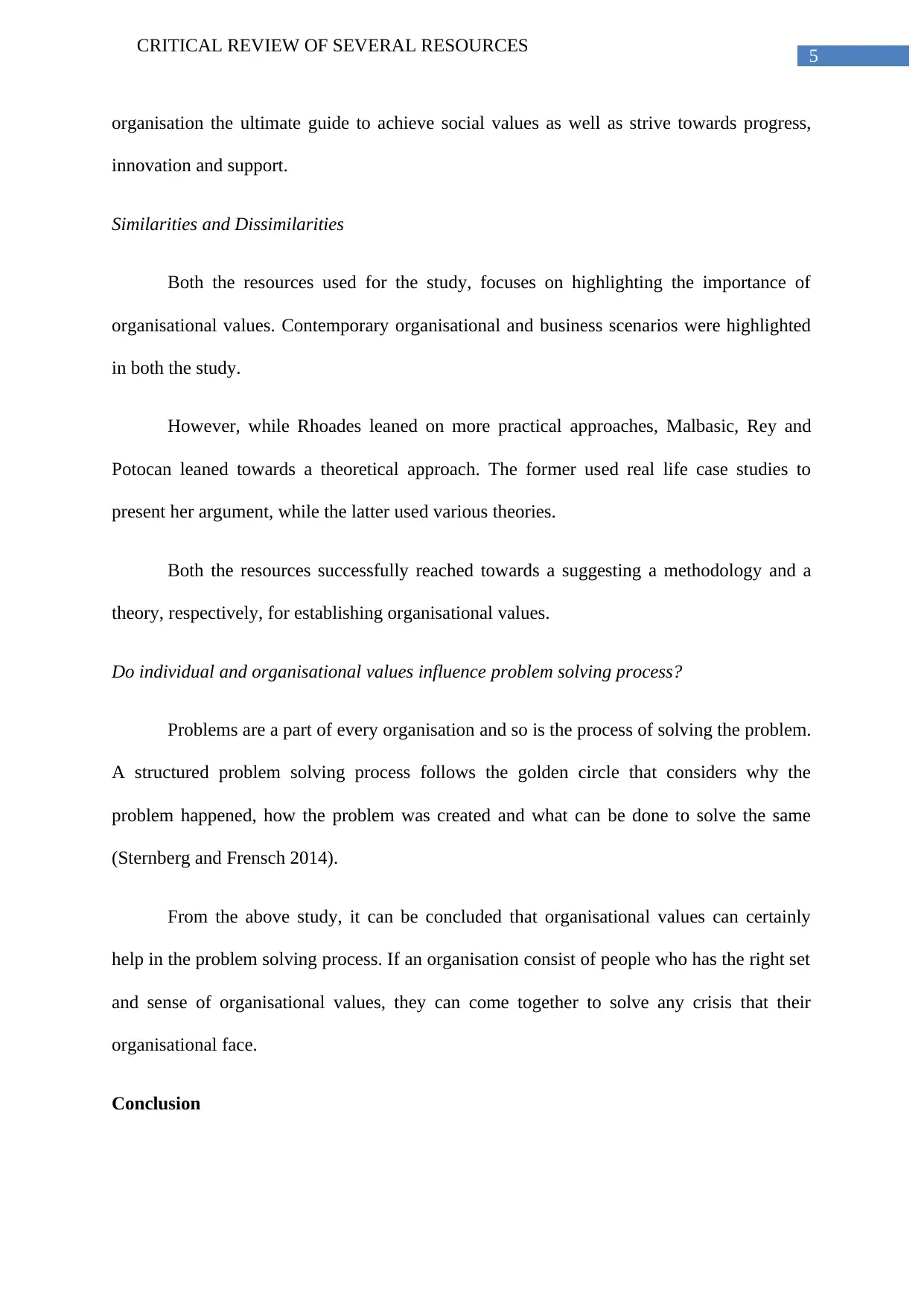
5
CRITICAL REVIEW OF SEVERAL RESOURCES
organisation the ultimate guide to achieve social values as well as strive towards progress,
innovation and support.
Similarities and Dissimilarities
Both the resources used for the study, focuses on highlighting the importance of
organisational values. Contemporary organisational and business scenarios were highlighted
in both the study.
However, while Rhoades leaned on more practical approaches, Malbasic, Rey and
Potocan leaned towards a theoretical approach. The former used real life case studies to
present her argument, while the latter used various theories.
Both the resources successfully reached towards a suggesting a methodology and a
theory, respectively, for establishing organisational values.
Do individual and organisational values influence problem solving process?
Problems are a part of every organisation and so is the process of solving the problem.
A structured problem solving process follows the golden circle that considers why the
problem happened, how the problem was created and what can be done to solve the same
(Sternberg and Frensch 2014).
From the above study, it can be concluded that organisational values can certainly
help in the problem solving process. If an organisation consist of people who has the right set
and sense of organisational values, they can come together to solve any crisis that their
organisational face.
Conclusion
CRITICAL REVIEW OF SEVERAL RESOURCES
organisation the ultimate guide to achieve social values as well as strive towards progress,
innovation and support.
Similarities and Dissimilarities
Both the resources used for the study, focuses on highlighting the importance of
organisational values. Contemporary organisational and business scenarios were highlighted
in both the study.
However, while Rhoades leaned on more practical approaches, Malbasic, Rey and
Potocan leaned towards a theoretical approach. The former used real life case studies to
present her argument, while the latter used various theories.
Both the resources successfully reached towards a suggesting a methodology and a
theory, respectively, for establishing organisational values.
Do individual and organisational values influence problem solving process?
Problems are a part of every organisation and so is the process of solving the problem.
A structured problem solving process follows the golden circle that considers why the
problem happened, how the problem was created and what can be done to solve the same
(Sternberg and Frensch 2014).
From the above study, it can be concluded that organisational values can certainly
help in the problem solving process. If an organisation consist of people who has the right set
and sense of organisational values, they can come together to solve any crisis that their
organisational face.
Conclusion
⊘ This is a preview!⊘
Do you want full access?
Subscribe today to unlock all pages.

Trusted by 1+ million students worldwide
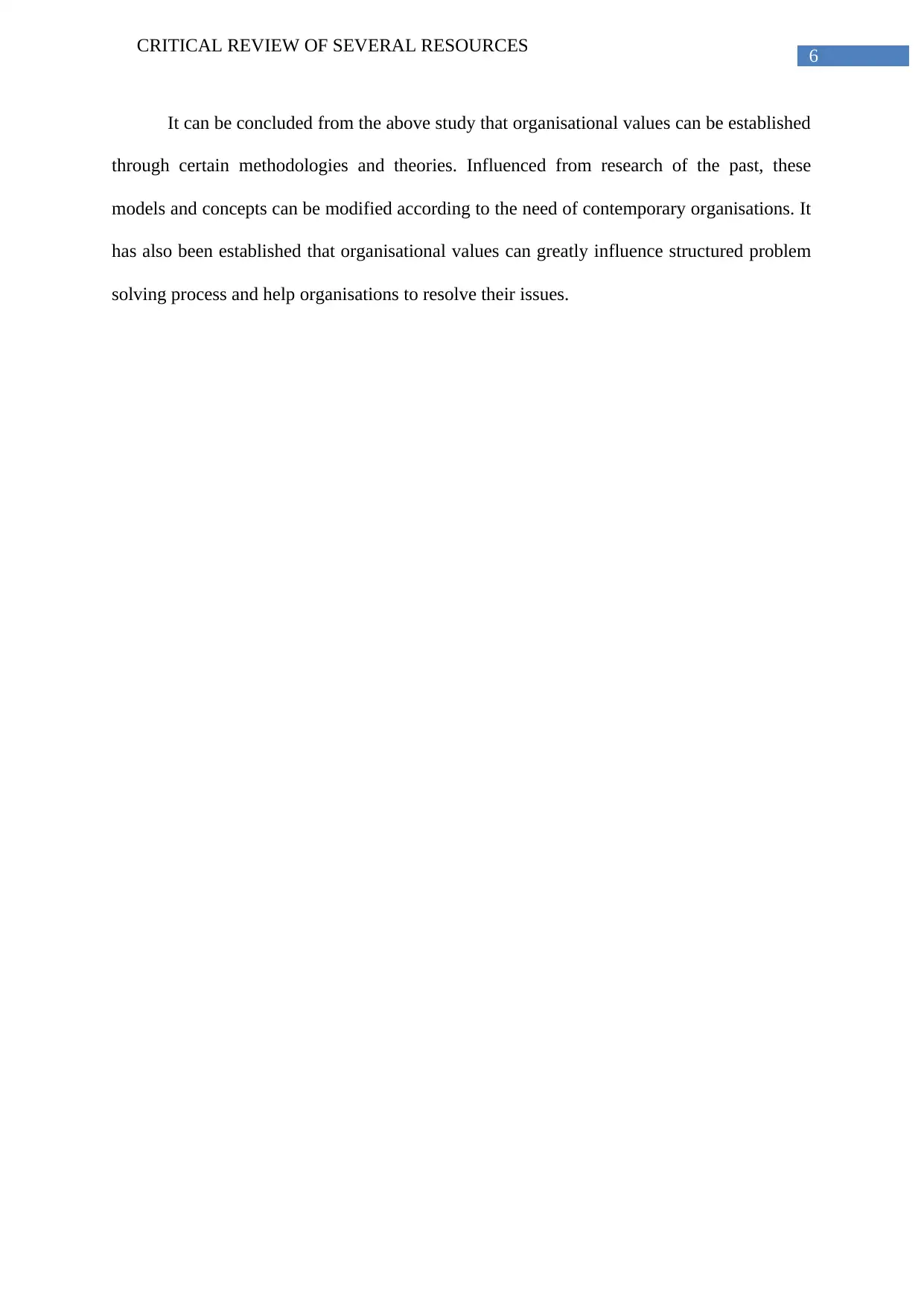
6
CRITICAL REVIEW OF SEVERAL RESOURCES
It can be concluded from the above study that organisational values can be established
through certain methodologies and theories. Influenced from research of the past, these
models and concepts can be modified according to the need of contemporary organisations. It
has also been established that organisational values can greatly influence structured problem
solving process and help organisations to resolve their issues.
CRITICAL REVIEW OF SEVERAL RESOURCES
It can be concluded from the above study that organisational values can be established
through certain methodologies and theories. Influenced from research of the past, these
models and concepts can be modified according to the need of contemporary organisations. It
has also been established that organisational values can greatly influence structured problem
solving process and help organisations to resolve their issues.
Paraphrase This Document
Need a fresh take? Get an instant paraphrase of this document with our AI Paraphraser
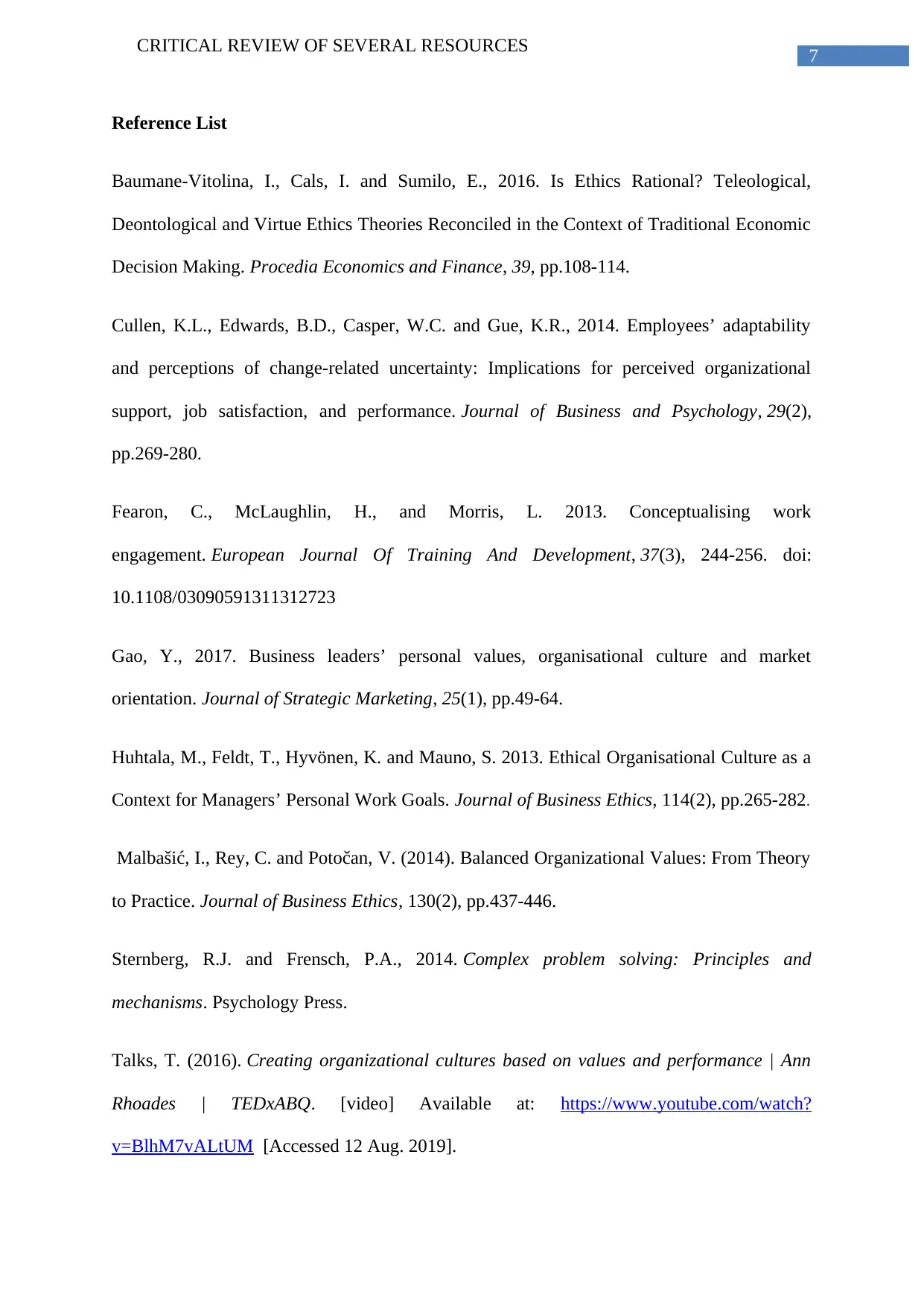
7
CRITICAL REVIEW OF SEVERAL RESOURCES
Reference List
Baumane-Vitolina, I., Cals, I. and Sumilo, E., 2016. Is Ethics Rational? Teleological,
Deontological and Virtue Ethics Theories Reconciled in the Context of Traditional Economic
Decision Making. Procedia Economics and Finance, 39, pp.108-114.
Cullen, K.L., Edwards, B.D., Casper, W.C. and Gue, K.R., 2014. Employees’ adaptability
and perceptions of change-related uncertainty: Implications for perceived organizational
support, job satisfaction, and performance. Journal of Business and Psychology, 29(2),
pp.269-280.
Fearon, C., McLaughlin, H., and Morris, L. 2013. Conceptualising work
engagement. European Journal Of Training And Development, 37(3), 244-256. doi:
10.1108/03090591311312723
Gao, Y., 2017. Business leaders’ personal values, organisational culture and market
orientation. Journal of Strategic Marketing, 25(1), pp.49-64.
Huhtala, M., Feldt, T., Hyvönen, K. and Mauno, S. 2013. Ethical Organisational Culture as a
Context for Managers’ Personal Work Goals. Journal of Business Ethics, 114(2), pp.265-282.
Malbašić, I., Rey, C. and Potočan, V. (2014). Balanced Organizational Values: From Theory
to Practice. Journal of Business Ethics, 130(2), pp.437-446.
Sternberg, R.J. and Frensch, P.A., 2014. Complex problem solving: Principles and
mechanisms. Psychology Press.
Talks, T. (2016). Creating organizational cultures based on values and performance | Ann
Rhoades | TEDxABQ. [video] Available at: https://www.youtube.com/watch?
v=BlhM7vALtUM [Accessed 12 Aug. 2019].
CRITICAL REVIEW OF SEVERAL RESOURCES
Reference List
Baumane-Vitolina, I., Cals, I. and Sumilo, E., 2016. Is Ethics Rational? Teleological,
Deontological and Virtue Ethics Theories Reconciled in the Context of Traditional Economic
Decision Making. Procedia Economics and Finance, 39, pp.108-114.
Cullen, K.L., Edwards, B.D., Casper, W.C. and Gue, K.R., 2014. Employees’ adaptability
and perceptions of change-related uncertainty: Implications for perceived organizational
support, job satisfaction, and performance. Journal of Business and Psychology, 29(2),
pp.269-280.
Fearon, C., McLaughlin, H., and Morris, L. 2013. Conceptualising work
engagement. European Journal Of Training And Development, 37(3), 244-256. doi:
10.1108/03090591311312723
Gao, Y., 2017. Business leaders’ personal values, organisational culture and market
orientation. Journal of Strategic Marketing, 25(1), pp.49-64.
Huhtala, M., Feldt, T., Hyvönen, K. and Mauno, S. 2013. Ethical Organisational Culture as a
Context for Managers’ Personal Work Goals. Journal of Business Ethics, 114(2), pp.265-282.
Malbašić, I., Rey, C. and Potočan, V. (2014). Balanced Organizational Values: From Theory
to Practice. Journal of Business Ethics, 130(2), pp.437-446.
Sternberg, R.J. and Frensch, P.A., 2014. Complex problem solving: Principles and
mechanisms. Psychology Press.
Talks, T. (2016). Creating organizational cultures based on values and performance | Ann
Rhoades | TEDxABQ. [video] Available at: https://www.youtube.com/watch?
v=BlhM7vALtUM [Accessed 12 Aug. 2019].
1 out of 8
Related Documents
Your All-in-One AI-Powered Toolkit for Academic Success.
+13062052269
info@desklib.com
Available 24*7 on WhatsApp / Email
![[object Object]](/_next/static/media/star-bottom.7253800d.svg)
Unlock your academic potential
Copyright © 2020–2025 A2Z Services. All Rights Reserved. Developed and managed by ZUCOL.




